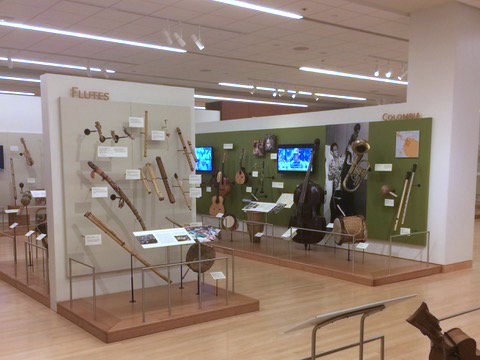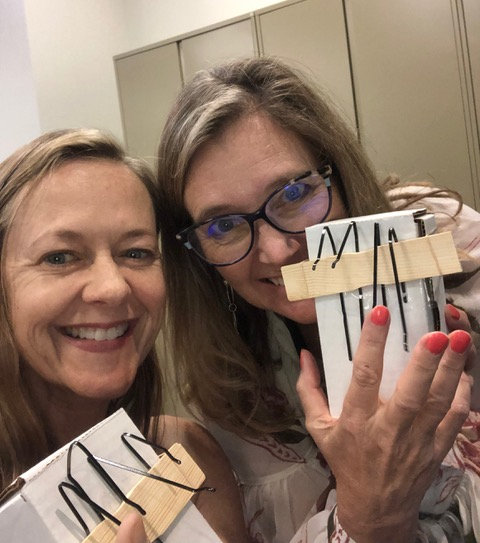I thought the MIM was a beautiful celebration of instrumental music. From the massive collections to the Steinway in the hall, they captured human music-making in a beautiful way. – Matt Fernald
I was immediately in awe of the MIM on first approach, as the building seemed to take over the horizon when we neared it. Inside, I felt transported to every corner of the globe, learning the history and presentation of music from nearly every country. Not to mention a great wing of American artifacts from jazz to blues to rock and roll. A must-see in Phoenix. – David Meyers
It was a tremendous pleasure to be receiving a training for once instead of giving one. I was so happy to be in the hands of competent music teachers of young children. And an added bonus was getting to play the harmonium! That instrument has been dancing around my peripheral hearing for a number of years now, with me always wondering how easy or hard it might be to play. I literally jumped out of my seat when I saw that we had an opportunity to play one. The whole day was a treat because the basic philosophy of the museum is so hands-on (and ears on!), making it the perfect place for musicians to visit. – Joanie Calem
I left the museum inspired to create drums from recycled materials with my kids and kids I teach at school. – Susie Tallman
In a world divided by ethnicity, religion, politics, and so much more, the Musical Instrument Museum (MIM) in Phoenix is a strong reminder of the cultural ties that bind us. As you take a moment to play the reverberating gamelan of Indonesia, pluck a thumb piano (mbira) from Zimbabwe, and enjoy listening to the icons of America’s history of rock, you can’t help sensing the musical instinct that deeply connects humans, whatever our origins.
About fifty CMN members came to Phoenix before the September 2019 conference for a day-long visit to MIM. One of MIM’s best features is the easy-to-use headset that allows you to play music videos at hundreds of exhibits. You see the instruments on display and you also see and hear them being played by musicians in their country of origin. In some rooms, visitors are also invited to play instruments.
The museum is set up by regions of the globe: Africa, the Middle East, Asia, Oceana, Europe, and the Americas. Within each region, exhibits focus on each country’s music, with the implicit acknowledgement that musical instruments and styles frequently travel across borders and far beyond their birthplace. One truth that emerges is that we humans share a collective desire to express rhythm, melody, and harmony via tapping, plucking, strumming, rubbing, bowing, and pushing air into whatever materials we might find handy. And of course, singing and dancing.
 World instruments on display at MIM (photo by David Myers)
World instruments on display at MIM (photo by David Myers)
It starts, as humanity did, in Africa. The museum’s collection features nearly 2,000 instruments from Africa (the collection is divided between countries in North Africa and sub-Saharan Africa). According the MIM guidebook, these instruments “include drums, xylophones, sanzas, gongs, bells, rattles, and bullroarers.”
I didn’t get a chance at the museum to find out what a bullroarer is. It turns out this instrument—a wood slat that makes a vibrato sound by being swung around in a fast circle on a long cord or string—is a perfect example of what the museum shows: instruments of a similar nature have turned up in cultures all over the world. The bullroarer, according to Wikipedia, has been found in Europe, Asia, the Indian sub-continent, Africa, the Americas, and Australia.
Stringed instruments, of course, have similarly been found in cultures around the globe. Consider an ancient instrument such as the lute. Among the many lutes in MIM’s collection are the cümbüş, a plucked lute from Turkey; the ud from Iraq; the kamaicha, a bowed lute from India; and the exquisitely decorated huxtar from China.
Despite these similarities, differences also emerge. An African drum, we learned, is not merely a drum. In many cultures, an elaborately carved drum represents a story or the voice of an ancestor. This attribution of human characteristics to an object is called anthropomorphism. According the MIM’s materials, “In many cases, the sounds of an anthropomorphic musical instrument are believed to literally embody the voice of the depicted ancestor or god.”
While the long history of instruments is one of MIM’s strong points, the museum also offers insights into popular music of the past century, especially in American and European cultures. You can take a journey through the history of rock and roll and explore the origins of jazz and the blues. You can sample a wacky musical experience of yesteryear by listening to the “Apollonia” orchestrion, which is essentially a band in a very large box. You can sample the music of the present and future with live performances, synthesizers, and a recording studio.
MIM also prides itself on its educational programs. CMN attendees received an excellent workshop put on by two museum staffers. Lots of CMN members lead workshops and classes on children’s music; some probably wondered what more they could teach us. The content and instruction were absolutely excellent, including a chance to sample lessons from the museum’s programs for children.
Katherine “Katy” Palmer, the museum’s Curator of Education, demonstrated a variety of activities from the museum’s early childhood classes, including musical play with the use of feathers. She credited this activity to Jo Kirk, a teacher in the Kodaly musical pedagogy.
Palmer discussed how she passes out feathers to children in a music class, asking children to examine the feathers and describe their characteristics. (The feather is soft; it’s light.) In an opposites lesson, the teacher can ask the opposites of “soft” and “light.”
Children are asked to hold the feathers high in the air, then let them drift to the ground. As the feathers descend, the teacher and others can sing descending pitches. This can lead to discussion of more opposites (high and low, up and down, fast and slow).
 Susie Tallman and Alice Burba show off mbiras crafted in the MIM workshop (photo by Susie Tallman)
Susie Tallman and Alice Burba show off mbiras crafted in the MIM workshop (photo by Susie Tallman)
Children can also be asked to catch the feather as it’s dropping and to place the feather on the back of their hand or some other body part. Then the teacher challenges the children to move, while not letting the feather fly away. (They soon discover that this movement must happen very slowly!)
Part of the purpose of the feather lesson is to observe and assess how children move through space. Are they in control? Can they move slowly and keep the feather from falling? Do they have the mastery of hand-eye coordination to catch the feather?
Palmer’s hands-on activities also offered each participant a chance to create a thumb piano out of a cardboard box, bobby pins, and rubber bands. The sound is . . . not bad.
For activities such as these, the museum’s web page includes curriculum guides for a variety of topics, including lessons such as the feather one. Here is a link to MIM’s early childhood curriculum.
The Museum’s Global Classroom program integrates music into learning about many cultures in our own country and the world. We learned folk songs from Korea, China, Spain, and West Africa, including a Spanish version of “Itsy Bitsy Spider.” Many American song leaders have learned a Spanish language “Itsy Bitsy,” titled “La Araña Pequiñita.” The spider song from Spain, “La Araña Chiquitita,” provides a slightly different tune and lyrics with a “Boom” in the middle. Here’s “La Araña Chiquitita” (lyrics and video) on Mama Lisa’s World.
The instruments, songs, and lessons at MIM added greatly to the experience of CMN members who traveled to Phoenix for the conference and made many of us want to return. Next time I go, I want to be sure to check out the bullroarer!